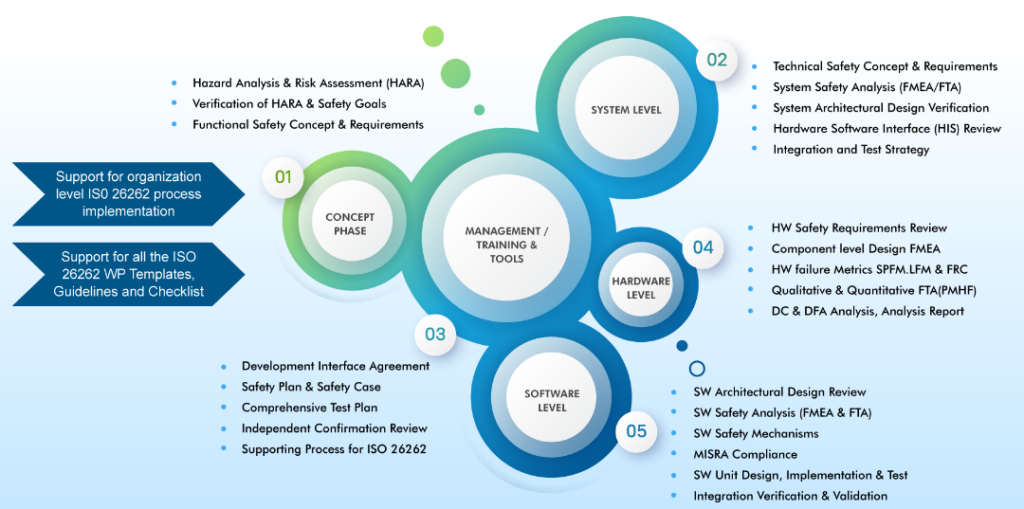Driving Safety: How Functional Safety Transforms Automotive and Systems Engineering
The automotive industry is undergoing a transformative era, driven by advancements in automation, electrification, and connectivity. While these innovations enhance vehicle capabilities, they also introduce new risks, making functional safety a cornerstone of modern automotive design. Functional safety ensures that systems operate reliably even in the presence of faults, preventing hazardous situations and safeguarding passengers and road users.
Why is functional safety so important? Simply put, it ensures that system failures don’t lead to accidents. ECUs control so many vital functions, and a malfunction in any of them could be catastrophic. In the world of autonomous and electric vehicles, reliability is even more critical. Software-Defined Vehicles (SDVs) rely on intricate algorithms, sensor fusion, and AI to make real-time decisions. A failure in any of these systems could have fatal consequences.
Understanding Functional Safety and ISO 26262
Functional safety in automotive refers to the prevention of unacceptable risks caused by electrical or electronic (E/E) system malfunctions. The ISO 26262 standard governs this domain, providing a structured framework to identify, analyze, and mitigate risks throughout a vehicle’s lifecycle. It defines safety processes such as Hazard Analysis and Risk Assessment (HARA) to identify potential hazards and assign Automotive Safety Integrity Levels (ASILs) based on risk severity.

HARA involves identifying hazardous events, evaluating their severity, exposure likelihood, and controllability, and defining safety goals. From there, detailed safety requirements are specified, the system architecture is designed for redundancy and fault tolerance, and rigorous software and hardware development is undertaken using safety-critical tools and techniques. Extensive verification and validation, including various testing methods and simulation, ensure the system meets safety requirements. Finally, a comprehensive safety case documents the entire process, proving compliance.
Benefits of Functional Safety in Automotive
Enhanced Reliability: Functional safety ensures that vehicles operate safely under all conditions, reducing the risk of accidents caused by system failures.
Consumer Confidence: Robust safety measures build trust in advanced technologies like autonomous systems.
Regulatory Compliance: Adherence to ISO 26262 ensures compliance with global safety standards.
Cost Savings: Early identification of risks prevents expensive recalls or post-production fixes.
Challenges in Implementing Functional Safety
Complex E/E Architectures: Modern vehicles integrate numerous electronic systems, making fault tolerance design and hazard analysis challenging.
ASIL Compliance: Determining and meeting high Automotive Safety Integrity Levels (ASILs) requires rigorous processes and resource allocation.
Verification and Validation: Comprehensive testing for all failure modes is resource-intensive and time-consuming.
Rapid Technological Advancements: Keeping pace with evolving technologies like AI and autonomous systems adds complexity.
Documentation and Traceability: Maintaining thorough records to meet ISO 26262 requirements is labor-intensive.
Overcoming Challenges
To address these challenges
- ● Adopt systematic tools for traceability and documentation to streamline compliance efforts.
- ● Foster collaboration between teams through standardized communication protocols.
- ● Invest in training engineers on ISO 26262 principles to build in-house expertise.
- ● Leverage advanced simulation tools for efficient testing and validation.
Functional safety aligns seamlessly with systems engineering through their shared focus on structured development processes. The functional safety V-model emphasizes hazard analysis, risk assessment, and validation at every stage, while the systems engineering V-model emphasizes on iterative approach to development and validation, ensuring that every stage of design—from requirements analysis to system integration—is mirrored by corresponding verification and testing activities. By integrating these models:
- ● Safety considerations are embedded into every phase of development.
- ● Teams achieve a holistic view of system interactions, ensuring no gaps between design objectives and safety goals.
Conclusion
As vehicles become increasingly complex with autonomous capabilities and electrification, functional safety is pivotal to ensuring reliability and consumer trust. By combining functional safety principles with systems engineering methodologies, automotive manufacturers can create safer vehicles that meet stringent regulatory standards while driving innovation. Overcoming implementation challenges through collaboration, training, and advanced tools will pave the way for a secure future in mobility.
If you are interested in understanding how to adopt systems engineering and model based systems engineering practices within your organization, reach out to BlueKei Solutions team at info@Blue-Kei.com. We specialize in systems engineering consulting, project executions, process adoptions such as compliance to ISO15288, ARP 4754A, ISO 42020, digital transformations. We can also conduct capability development workshops which are experiential and tailored to your needs. With systems engineering adoption you can address the complexity, manage evolving risks and bring transformation in communication within your organization through digitalization and create the digital thread.

